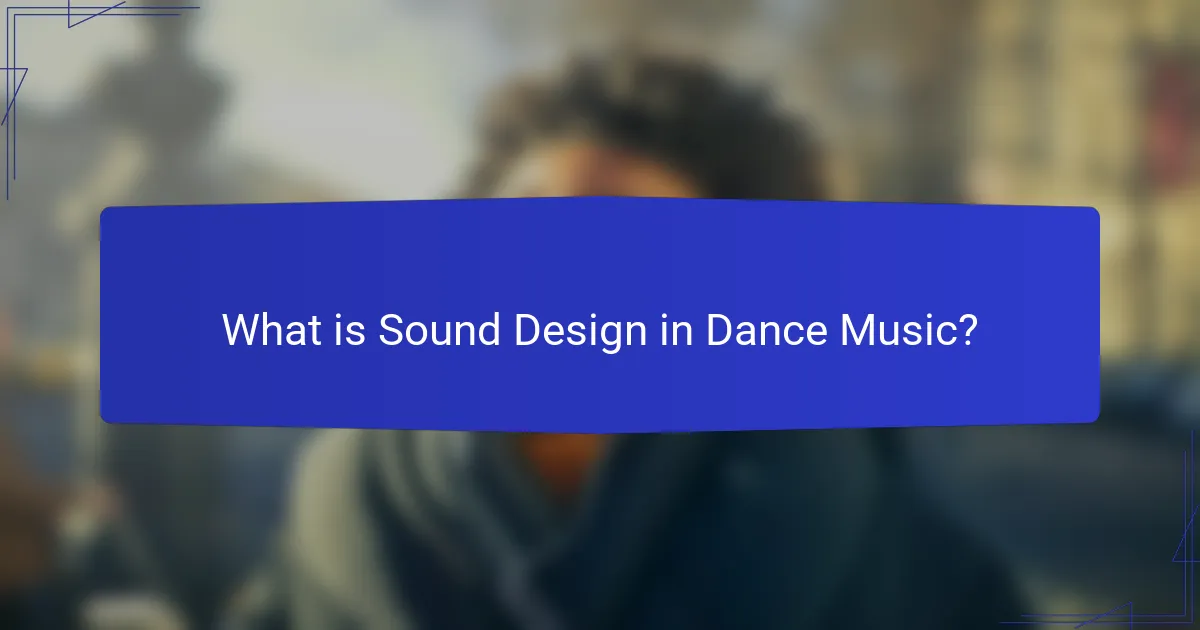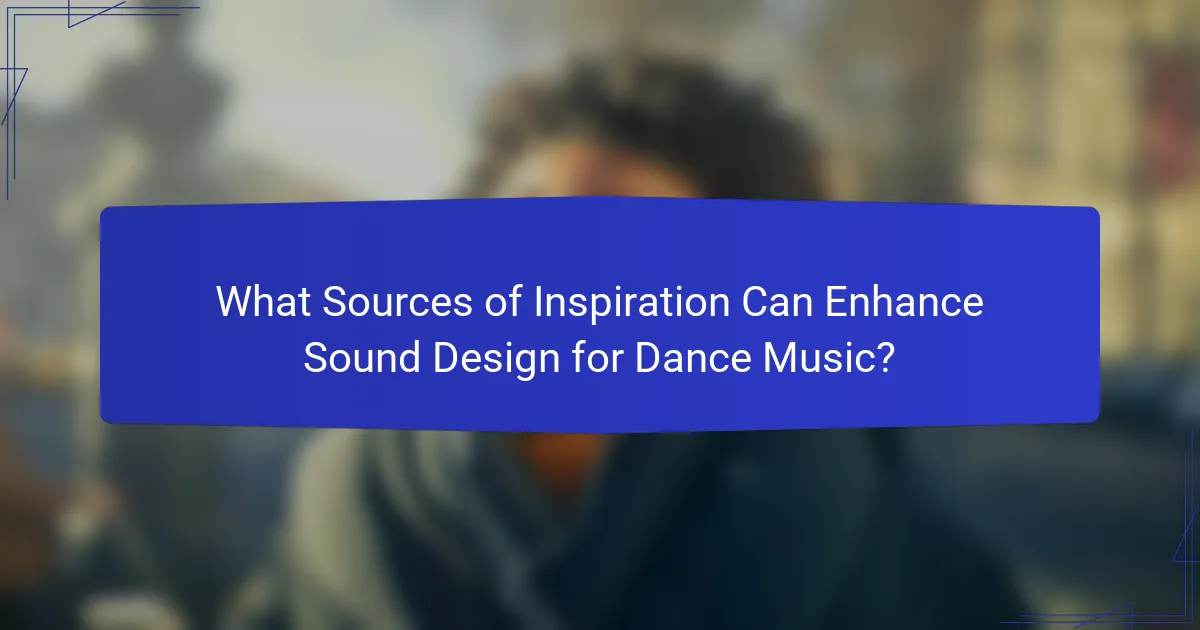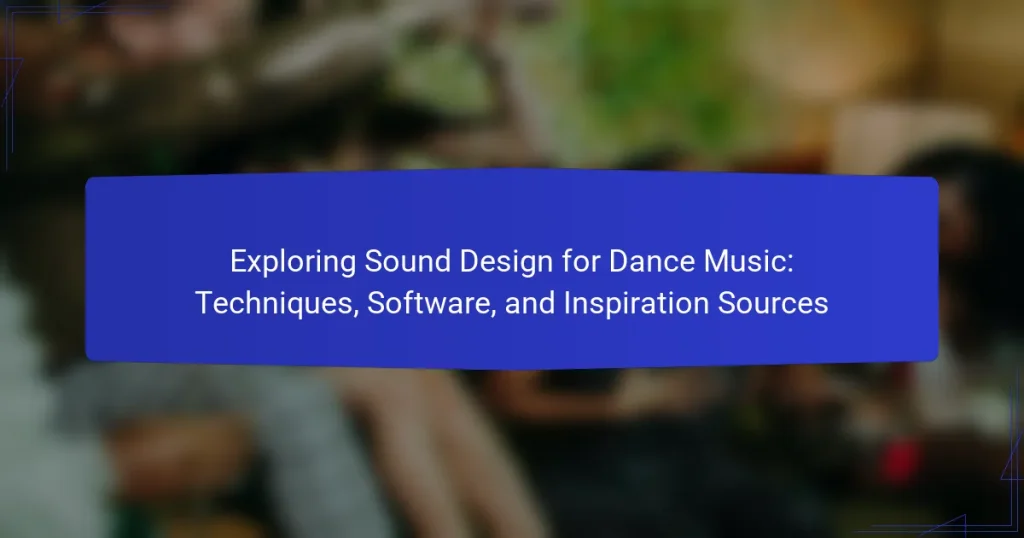Sound design in dance music involves the creation and manipulation of audio elements using synthesizers, samplers, and effects to craft unique sounds. Key techniques include synthesis, sampling, effects processing, and layering, which enhance the emotional impact of tracks. Popular software tools such as Ableton Live, FL Studio, and Logic Pro X support producers in these processes, offering features that boost creativity and workflow efficiency. Additionally, inspiration for sound design can come from nature sounds, urban environments, various music genres, and collaboration with other artists, encouraging experimentation and the development of distinctive sounds.

What is Sound Design in Dance Music?
Sound design in dance music refers to the process of creating and manipulating audio elements to produce unique sounds. This involves using synthesizers, samplers, and effects to craft beats, melodies, and textures. Sound designers focus on various aspects such as timbre, pitch, and rhythm. They often employ techniques like layering sounds and applying modulation. Software tools like Ableton Live and FL Studio are commonly used in this field. The goal is to enhance the emotional impact of the music. Effective sound design can differentiate a track in a crowded genre. Notable dance music producers often emphasize the importance of sound design in their creative process.
How does sound design influence the overall experience of dance music?
Sound design significantly influences the overall experience of dance music. It shapes the sonic landscape, creating distinct atmospheres and emotions. Effective sound design enhances rhythm, making tracks more engaging. Unique sounds can differentiate artists, establishing their signature style. Layering sounds adds depth, enriching the listening experience. Additionally, sound design affects the energy levels within a track. For instance, build-ups and drops are crucial in dance music, relying heavily on sound design techniques. Research shows that well-crafted sound design can increase listener retention and enjoyment, as seen in popular dance tracks.
What are the key elements that define sound design in this genre?
Key elements that define sound design in dance music include rhythm, texture, and modulation. Rhythm is essential as it drives the energy and movement in tracks. Texture involves layering sounds to create depth and richness. Modulation adds interest by changing parameters over time, such as pitch and filter settings. Additionally, synthesis techniques, like subtractive and additive synthesis, play a crucial role in creating unique sounds. Effects processing, including reverb and delay, enhances the spatial quality of the mix. These elements work together to shape the overall sonic identity of dance music.
How does sound design differentiate various sub-genres of dance music?
Sound design differentiates various sub-genres of dance music through unique sonic characteristics and production techniques. Each sub-genre employs specific sounds, such as deep basslines in house music or sharp snares in techno. The use of synthesizers and samples varies widely among sub-genres. For instance, trance often features ethereal pads, while dubstep relies on heavy wobbles and drops. Additionally, tempo and rhythm patterns contribute to the distinctiveness of each sub-genre. House music typically ranges from 120 to 130 BPM, while drum and bass can exceed 170 BPM. The choice of effects, such as reverb and delay, also shapes the overall sound. Ultimately, these elements create a recognizable identity for each sub-genre within the broader dance music landscape.
Why is sound design crucial for dance music producers?
Sound design is crucial for dance music producers because it shapes the overall sound and feel of their tracks. Unique sound design allows producers to create distinctive sonic identities. This differentiation is essential in a competitive music landscape. High-quality sound design enhances listener engagement and emotional impact. It also enables the manipulation of sounds to fit specific genres or moods. According to a study by the University of California, sound design significantly influences audience perception and enjoyment of music. Effective sound design techniques can elevate production quality and increase marketability. Ultimately, sound design is foundational for creativity and innovation in dance music production.
What role does sound design play in creating emotional responses in listeners?
Sound design plays a crucial role in creating emotional responses in listeners. It shapes the auditory experience by influencing mood and perception. Specific sounds can evoke distinct feelings. For example, major chords often elicit happiness, while minor chords can create sadness. The texture of sounds also impacts emotions; smooth sounds may induce calmness, while harsh sounds can provoke tension. Research shows that sound frequencies can affect brain activity linked to emotional processing. This connection is evident in film scores, where sound design enhances storytelling by amplifying emotional moments. Thus, effective sound design is essential for engaging listeners emotionally in dance music.
How can sound design enhance the danceability of a track?
Sound design can enhance the danceability of a track by creating rhythmic and dynamic elements. It shapes the way sounds interact to drive movement. Well-crafted beats and basslines provide a solid foundation for dancers. Layering sounds adds texture and complexity, making the music more engaging. The use of syncopation creates unexpected rhythms that invite movement. High-energy sound effects can elevate excitement and encourage dancing. Additionally, the choice of instruments influences the overall groove. For instance, percussive elements can stimulate physical response. Ultimately, thoughtful sound design aligns with the tempo, making tracks more compelling for dancers.

What Techniques are Essential for Sound Design in Dance Music?
Essential techniques for sound design in dance music include synthesis, sampling, and effects processing. Synthesis involves creating sounds from scratch using oscillators and filters. This allows for unique sound creation tailored to a track’s needs. Sampling involves using pre-recorded sounds or loops to add texture and depth. It can incorporate a variety of audio sources, enhancing creativity. Effects processing applies tools like reverb, delay, and distortion to modify sounds. This shapes the sonic character and adds spatial dimensions. Layering sounds is another crucial technique, combining multiple elements to create a fuller mix. Additionally, automation controls parameters over time, adding dynamic movement to sounds. These techniques are widely used by producers to craft engaging and danceable tracks.
What are the fundamental techniques used in sound design for dance music?
The fundamental techniques used in sound design for dance music include synthesis, sampling, and effects processing. Synthesis involves creating sounds from scratch using oscillators, filters, and envelopes. This technique allows producers to design unique sounds tailored to their tracks. Sampling involves using pre-recorded audio snippets, which can be manipulated to fit the desired context. This technique is widely used in dance music for creating beats and melodic elements. Effects processing includes applying reverb, delay, and distortion to enhance sounds and create depth. These techniques are essential for crafting the energetic and dynamic soundscapes characteristic of dance music.
How do layering and sampling contribute to sound design?
Layering and sampling are essential techniques in sound design. Layering involves combining multiple sounds to create a rich, textured audio experience. This technique enhances depth and complexity in music production. Sampling refers to using pre-recorded sounds in new compositions. It allows for the incorporation of diverse sonic elements. Together, layering and sampling enable sound designers to craft unique auditory landscapes. They facilitate experimentation and innovation in dance music. The use of these techniques can result in distinctive sound signatures that stand out in the genre.
What is the importance of synthesis in creating unique sounds?
Synthesis is crucial for creating unique sounds in music production. It allows sound designers to manipulate waveforms, frequencies, and modulation. By using synthesis, producers can generate sounds that are not confined to pre-recorded samples. This flexibility leads to innovative textures and timbres. Synthesis enables the layering of different sound elements, enhancing complexity. Techniques such as subtractive, additive, and FM synthesis each offer distinct sonic possibilities. The ability to customize parameters leads to original sound creation. Unique sounds can significantly impact the emotional and atmospheric quality of dance music.
How can effects processing shape the sound in dance music?
Effects processing can significantly shape the sound in dance music. It alters audio signals to create unique textures and enhance overall sound quality. Common effects include reverb, delay, distortion, and modulation. Reverb adds depth and space, making sounds feel more immersive. Delay creates rhythmic patterns, enhancing the groove of a track. Distortion adds warmth and grit, making sounds more aggressive. Modulation effects like chorus and flanger introduce movement, enriching the sonic landscape. These techniques are essential for achieving the dynamic and energetic sound characteristic of dance music.
What types of effects are commonly used in dance music production?
Common effects used in dance music production include reverb, delay, compression, and distortion. Reverb adds space and depth to sounds. It simulates the natural reflections of sound in an environment. Delay creates echoes, enhancing rhythmic elements. Compression controls the dynamic range of audio signals. It ensures consistent volume levels in a mix. Distortion adds warmth and character to sounds. It can make elements more aggressive or pronounced. Other effects include chorus, flanger, and phaser, which create modulation and movement in the sound. These effects are essential for shaping the overall sonic landscape in dance music.
How do modulation and automation enhance sound design?
Modulation and automation enhance sound design by adding dynamic movement and variation to audio. Modulation involves altering sound parameters over time, creating evolving textures. It can affect aspects like pitch, filter cutoff, or amplitude. This results in sounds that are more engaging and less static. Automation, on the other hand, involves programming changes in parameters at specific points in a track. This allows for precise control over effects and instrument behaviors. Together, they enable sound designers to craft intricate soundscapes. For instance, using modulation to vary a synth’s filter can create a richer tone. Automation can ensure that a reverb effect swells at a climactic moment. These techniques are essential for producing compelling dance music that captivates listeners.

Which Software Tools are Best for Sound Design in Dance Music?
Ableton Live, FL Studio, and Logic Pro X are among the best software tools for sound design in dance music. Ableton Live offers a flexible interface and powerful sampling capabilities. It is widely used for live performances and studio production. FL Studio is known for its intuitive step sequencer and extensive plugin support. Many producers favor it for its user-friendly design. Logic Pro X provides a comprehensive suite of virtual instruments and effects. Its MIDI capabilities are highly regarded in the industry. These tools are popular due to their features that enhance creativity and workflow efficiency.
What are the most popular digital audio workstations (DAWs) for dance music production?
The most popular digital audio workstations (DAWs) for dance music production include Ableton Live, FL Studio, and Logic Pro. Ableton Live is favored for its real-time performance capabilities and user-friendly interface. FL Studio is known for its intuitive step sequencer and extensive plugin support. Logic Pro offers a comprehensive suite of tools and high-quality virtual instruments. According to a 2022 survey by Sound on Sound, these DAWs consistently rank among the top choices for electronic music producers. Their popularity is attributed to their unique features that cater specifically to dance music production needs.
How do different DAWs compare in terms of sound design capabilities?
Different DAWs vary significantly in sound design capabilities. Ableton Live excels in its intuitive interface and real-time manipulation features. It offers extensive built-in instruments and effects tailored for electronic music. Logic Pro provides a vast library of high-quality samples and sophisticated MIDI capabilities. Its powerful synths and audio editing tools support complex sound design. FL Studio is known for its pattern-based workflow and robust plugin support. This allows for creative layering and sound experimentation. Pro Tools, while industry-standard for audio editing, may lack some creative features found in other DAWs. However, it excels in audio recording and mixing. Each DAW’s strengths cater to different sound design needs and preferences.
What plugins are essential for effective sound design in dance music?
Essential plugins for effective sound design in dance music include Serum, Massive, and Omnisphere. Serum is a wavetable synthesizer known for its high-quality sound and flexibility. Massive is renowned for its deep bass and rich leads, making it a staple in electronic music. Omnisphere offers a vast library of sounds and advanced synthesis capabilities.
Additionally, plugins like FabFilter Pro-Q for EQ and Valhalla Room for reverb are crucial for mixing and enhancing sound. These tools help shape and polish the final mix, ensuring clarity and depth. Many producers rely on these plugins to create professional-sounding tracks in the dance music genre.
How can sound design software impact the creative process?
Sound design software significantly enhances the creative process by providing tools for experimentation. These tools allow artists to manipulate audio in innovative ways. Features such as synthesizers, samplers, and effects enable unique sound creation. This flexibility encourages exploration beyond traditional methods. Additionally, software often includes pre-set sounds that inspire new ideas. Accessibility to high-quality sounds can accelerate production. Collaboration features in some software facilitate teamwork among creators. Overall, sound design software streamlines workflow, allowing artists to focus on creativity rather than technical limitations.
What features should producers look for in sound design software?
Producers should look for several key features in sound design software. First, a user-friendly interface enhances workflow efficiency. Second, a variety of sound synthesis options is essential. This includes subtractive, additive, and granular synthesis methods. Third, high-quality built-in effects help in shaping sounds. Producers benefit from effects like reverb, delay, and distortion. Fourth, MIDI compatibility allows for flexible music creation. This feature enables integration with other hardware and software instruments. Fifth, extensive preset libraries provide a starting point for sound exploration. Lastly, real-time audio processing capabilities are crucial for immediate feedback during sound design. These features collectively enhance the creative process and output quality in dance music production.
How do user interfaces of different software affect workflow?
User interfaces of different software significantly affect workflow by influencing user efficiency and task completion speed. Intuitive interfaces streamline navigation and reduce the learning curve, enabling users to focus on creative tasks. Conversely, complex or cluttered interfaces can hinder productivity and lead to frustration. For example, software with customizable layouts allows users to arrange tools according to their preferences, enhancing workflow. Research shows that well-designed interfaces can increase user satisfaction and decrease errors. A study by Nielsen Norman Group found that usability improvements can lead to productivity gains of up to 50%. Thus, the design of user interfaces plays a crucial role in determining how effectively users can achieve their goals within software.

What Sources of Inspiration Can Enhance Sound Design for Dance Music?
Nature sounds can enhance sound design for dance music. Field recordings of nature provide unique textures. Urban environments also offer interesting soundscapes. Listening to different genres can inspire new ideas. Classical music introduces rich harmonic structures. World music adds diverse rhythms and instrumentation. Art and visual media can spark creative concepts. Collaborating with other artists often leads to innovative sounds. These sources encourage experimentation and help develop a unique sound.
Where can producers find inspiration for innovative sound design?
Producers can find inspiration for innovative sound design in various sources. Nature sounds provide unique textures and rhythms. Field recordings capture real-world audio that can be manipulated creatively. Art installations often feature experimental soundscapes. Collaborating with other musicians can spark new ideas. Online platforms like SoundCloud showcase diverse sounds and styles. Social media groups focus on sound design discussions and sharing techniques. Music festivals expose producers to cutting-edge performances and trends. Finally, audio libraries offer a wealth of samples and sound effects for exploration.
How do listening to diverse genres influence sound design choices?
Listening to diverse genres influences sound design choices by broadening the palette of sounds and techniques available to creators. Exposure to various styles introduces unique rhythms, textures, and instrumentation. For instance, electronic music often incorporates elements from jazz, rock, and classical music. This fusion can lead to innovative soundscapes and unexpected combinations. Moreover, understanding genre-specific production techniques can enhance the effectiveness of sound design. Research indicates that genre diversity can stimulate creativity and improve problem-solving in music production (Hanna et al., 2020, Journal of Music Technology). Thus, incorporating influences from multiple genres fosters a richer sound design process.
What role do collaborations play in inspiring sound design techniques?
Collaborations significantly enhance sound design techniques by fostering creativity and innovation. Working with diverse artists brings fresh perspectives. These interactions often lead to the exploration of new sounds and methods. Collaborators can share unique skills and experiences. This exchange can inspire novel approaches to sound manipulation. For example, producers may experiment with different genres through collaboration. Research shows that collaborative projects often yield higher levels of creativity. A study by Sawyer (2007) highlights that teamwork can lead to more innovative outcomes in creative fields. Thus, collaborations play a crucial role in inspiring advancements in sound design techniques.
What are some best practices for developing a unique sound in dance music?
To develop a unique sound in dance music, focus on experimentation with various sound design techniques. Utilize synthesizers to create original patches and explore unconventional sound sources. Layering sounds can add depth and complexity to tracks. Incorporating field recordings and live instruments enhances authenticity. Use effects creatively to manipulate sounds, such as reverb and distortion. Collaborating with other artists can introduce fresh perspectives and ideas. Analyze successful tracks in your genre to identify unique elements. Constantly refine your skills through practice and feedback from peers.
How can experimentation lead to innovative sound design?
Experimentation can lead to innovative sound design by encouraging the exploration of new techniques and tools. It allows sound designers to break conventional boundaries. By manipulating sound sources, they can create unique textures and timbres. Experimentation fosters creativity through trial and error. This process often reveals unexpected results that can inspire new ideas. Historical examples include the use of tape manipulation in the 1960s. Artists like Brian Eno employed unconventional methods to generate novel soundscapes. The integration of technology, such as synthesizers and software, enhances this experimentation. Overall, it promotes a culture of innovation in sound design.
What tips can help producers overcome creative blocks in sound design?
Producers can overcome creative blocks in sound design by experimenting with new techniques. Trying different sound sources can spark fresh ideas. Collaborating with other artists often leads to innovative concepts. Setting specific time limits encourages focused creativity. Taking breaks can help clear the mind and provide new perspectives. Revisiting favorite sounds or tracks can reignite inspiration. Utilizing sound design software with unique features can stimulate creativity. Engaging in regular practice helps maintain a steady flow of ideas.
The main entity of the article is sound design in dance music, which encompasses the creation and manipulation of audio elements to produce distinctive sounds. The article provides an overview of essential techniques, including synthesis, sampling, and effects processing, alongside the impact of sound design on the overall experience and emotional responses in dance music. It also explores the role of software tools, such as Ableton Live and FL Studio, in enhancing the creative process, as well as the importance of collaboration and diverse genre influences in developing unique soundscapes. Additionally, it outlines best practices for overcoming creative blocks and fostering innovation in sound design.


